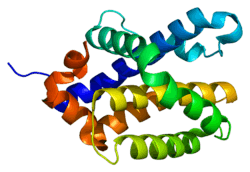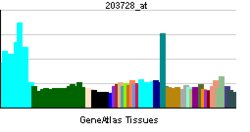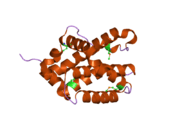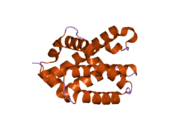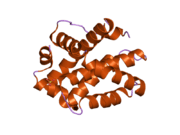Bcl-2 homologous antagonist killer
Bcl-2 homologous antagonist/killer is a protein that in humans is encoded by the BAK1 gene.[1][2] BAK1 orthologs [3] have been identified in most mammals for which complete genome data are available.
The BAK protein is a pro-apoptotic member of the Bcl-2 gene family which is involved in initiating apoptosis. Dysregulation of the BAK gene has been implicated in human gastrointestinal cancers, indicating that the gene plays a part in the pathogenesis of some cancers.[4]

Function
The protein encoded by this gene belongs to the BCL2 protein family. BCL2 family members form oligomers or heterodimers and act as anti- or pro-apoptotic regulators that are involved in a wide variety of cellular activities. This protein localizes to mitochondria, and functions to induce apoptosis. It interacts with and accelerates the opening of the mitochondrial voltage-dependent anion channel, which leads to a loss in membrane potential and the release of cytochrome c. This protein also interacts with the tumor suppressor P53 after exposure to cell stress.[5]
BAK1 gene variation
Recently, one study of the role of genetics in abdominal aortic aneurism (AAA) showed that different BAK1 variants can exist in both diseased and nondiseased AA tissues compared to matching blood samples.[6] Since its publication, this observation has raised many discussions among scientific community because it seems to jeopardize the current paradigm that all cells have the same genomic DNA. However, BAK1 gene variants in different tissues may be easily explained by the expression of BAK1 gene on chromosome 6 and one its edited copies on chromosome 20. This conjecture reconciles both the current paradigm and the observation of BAK1 gene variation in different tissues.[7][8] However, the authors of the BAK1 gene variations original article have published a response.[7]
Interactions
BAK1 has been shown to interact with:
References
- ↑ Chittenden T, Harrington EA, O'Connor R, Flemington C, Lutz RJ, Evan GI, Guild BC (May 1995). "Induction of apoptosis by the Bcl-2 homologue Bak". Nature 374 (6524): 733–6. doi:10.1038/374733a0. PMID 7715730.
- ↑ Kiefer MC, Brauer MJ, Powers VC, Wu JJ, Umansky SR, Tomei LD, Barr PJ (May 1995). "Modulation of apoptosis by the widely distributed Bcl-2 homologue Bak". Nature 374 (6524): 736–9. doi:10.1038/374736a0. PMID 7715731.
- ↑ "OrthoMaM phylogenetic marker: BAK1 coding sequence".
- ↑ Qiang-Song Tong et al. (2004). "BAK overexpression mediates p53-independent apoptosis inducing effects on human gastric cancer cells". BMC Cancer 4: 33. doi:10.1186/1471-2407-4-33. PMC 481072. PMID 15248898.
- ↑ "Entrez Gene: BAK1 BCL2-antagonist/killer 1".
- ↑ Gottlieb B, Chalifour LE, Mitmaker B, Sheiner N, Obrand D, Abraham C, Meilleur M, Sugahara T, Bkaily G, Schweitzer M (July 2009). "BAK1 gene variation and abdominal aortic aneurysms". Hum. Mutat. 30 (7): 1043–7. doi:10.1002/humu.21046. PMID 19514060.
- ↑ 7.0 7.1 Hatchwell E (January 2010). "BAK1 gene variation and abdominal aortic aneurysms-variants are likely due to sequencing of a processed gene on chromosome 20". Hum. Mutat. 31 (1): 108–9; author reply 110–1. doi:10.1002/humu.21147. PMID 19847788.
- ↑ Michel Eduardo Beleza Yamagishi (2009). "A simpler explanation to BAK1 gene variation in Aortic and Blood tissues". arXiv:0909.2321 [q-bio.GN].
- ↑ Rual JF, Venkatesan K, Hao T, Hirozane-Kishikawa T, Dricot A, Li N, Berriz GF, Gibbons FD, Dreze M, Ayivi-Guedehoussou N, Klitgord N, Simon C, Boxem M, Milstein S, Rosenberg J, Goldberg DS, Zhang LV, Wong SL, Franklin G, Li S, Albala JS, Lim J, Fraughton C, Llamosas E, Cevik S, Bex C, Lamesch P, Sikorski RS, Vandenhaute J, Zoghbi HY, Smolyar A, Bosak S, Sequerra R, Doucette-Stamm L, Cusick ME, Hill DE, Roth FP, Vidal M (October 2005). "Towards a proteome-scale map of the human protein-protein interaction network". Nature 437 (7062): 1173–8. doi:10.1038/nature04209. PMID 16189514.
- ↑ Zhang H, Nimmer P, Rosenberg SH, Ng SC, Joseph M (August 2002). "Development of a high-throughput fluorescence polarization assay for Bcl-x(L)". Anal. Biochem. 307 (1): 70–5. doi:10.1016/s0003-2697(02)00028-3. PMID 12137781.
- ↑ Whitfield J, Harada K, Bardelle C, Staddon JM (November 2003). "High-throughput methods to detect dimerization of Bcl-2 family proteins". Anal. Biochem. 322 (2): 170–8. doi:10.1016/j.ab.2003.07.014. PMID 14596824.
- ↑ 12.0 12.1 Willis SN, Chen L, Dewson G, Wei A, Naik E, Fletcher JI, Adams JM, Huang DC (June 2005). "Proapoptotic Bak is sequestered by Mcl-1 and Bcl-xL, but not Bcl-2, until displaced by BH3-only proteins". Genes Dev. 19 (11): 1294–305. doi:10.1101/gad.1304105. PMC 1142553. PMID 15901672.
- ↑ Zheng TS (February 2001). "Death by design: the big debut of small molecules". Nat. Cell Biol. 3 (2): E43–6. doi:10.1038/35055145.
- ↑ Lin B, Kolluri SK, Lin F, Liu W, Han YH, Cao X, Dawson MI, Reed JC, Zhang XK (February 2004). "Conversion of Bcl-2 from protector to killer by interaction with nuclear orphan receptor Nur77/TR3". Cell 116 (4): 527–40. doi:10.1016/s0092-8674(04)00162-x. PMID 14980220.
- ↑ Enyedy IJ, Ling Y, Nacro K, Tomita Y, Wu X, Cao Y, Guo R, Li B, Zhu X, Huang Y, Long YQ, Roller PP, Yang D, Wang S (December 2001). "Discovery of small-molecule inhibitors of Bcl-2 through structure-based computer screening". J. Med. Chem. 44 (25): 4313–24. doi:10.1021/jm010016f. PMID 11728179.
- ↑ 16.0 16.1 Perfettini JL, Kroemer RT, Kroemer G (May 2004). "Fatal liaisons of p53 with Bax and Bak". Nat. Cell Biol. 6 (5): 386–8. doi:10.1038/ncb0504-386. PMID 15122264.
- ↑ Weng C, Li Y, Xu D, Shi Y, Tang H (March 2005). "Specific cleavage of Mcl-1 by caspase-3 in tumor necrosis factor-related apoptosis-inducing ligand (TRAIL)-induced apoptosis in Jurkat leukemia T cells". J. Biol. Chem. 280 (11): 10491–500. doi:10.1074/jbc.M412819200. PMID 15637055.
- ↑ Bae J, Leo CP, Hsu SY, Hsueh AJ (August 2000). "MCL-1S, a splicing variant of the antiapoptotic BCL-2 family member MCL-1, encodes a proapoptotic protein possessing only the BH3 domain". J. Biol. Chem. 275 (33): 25255–61. doi:10.1074/jbc.M909826199. PMID 10837489.
Further reading
- Buytaert E, Callewaert G, Vandenheede JR, Agostinis P (2007). "Deficiency in apoptotic effectors Bax and Bak reveals an autophagic cell death pathway initiated by photodamage to the endoplasmic reticulum". Autophagy 2 (3): 238–40. doi:10.4161/auto.2730. PMID 16874066.
- Farrow SN; White JH; Martinou I et al. (1995). "Cloning of a bcl-2 homologue by interaction with adenovirus E1B 19K". Nature 374 (6524): 731–3. doi:10.1038/374731a0. PMID 7715729.
- Chittenden T; Flemington C; Houghton AB et al. (1996). "A conserved domain in Bak, distinct from BH1 and BH2, mediates cell death and protein binding functions". EMBO J. 14 (22): 5589–96. PMC 394673. PMID 8521816.
- Sattler M; Liang H; Nettesheim D et al. (1997). "Structure of Bcl-xL-Bak peptide complex: recognition between regulators of apoptosis". Science 275 (5302): 983–6. doi:10.1126/science.275.5302.983. PMID 9020082.
- Diaz JL; Oltersdorf T; Horne W et al. (1997). "A common binding site mediates heterodimerization and homodimerization of Bcl-2 family members". J. Biol. Chem. 272 (17): 11350–5. doi:10.1074/jbc.272.17.11350. PMID 9111042.
- Huang DC, Adams JM, Cory S (1998). "The conserved N-terminal BH4 domain of Bcl-2 homologues is essential for inhibition of apoptosis and interaction with CED-4". EMBO J. 17 (4): 1029–39. doi:10.1093/emboj/17.4.1029. PMC 1170452. PMID 9463381.
- Herberg JA; Phillips S; Beck S et al. (1998). "Genomic structure and domain organisation of the human Bak gene". Gene 211 (1): 87–94. doi:10.1016/S0378-1119(98)00101-2. PMID 9573342.
- Narita M; Shimizu S; Ito T et al. (1999). "Bax interacts with the permeability transition pore to induce permeability transition and cytochrome c release in isolated mitochondria". Proc. Natl. Acad. Sci. U.S.A. 95 (25): 14681–6. doi:10.1073/pnas.95.25.14681. PMC 24509. PMID 9843949.
- Song Q, Kuang Y, Dixit VM, Vincenz C (1999). "Boo, a novel negative regulator of cell death, interacts with Apaf-1". EMBO J. 18 (1): 167–78. doi:10.1093/emboj/18.1.167. PMC 1171112. PMID 9878060.
- Griffiths GJ; Dubrez L; Morgan CP et al. (1999). "Cell Damage-induced Conformational Changes of the Pro-Apoptotic Protein Bak In Vivo Precede the Onset of Apoptosis". J. Cell Biol. 144 (5): 903–14. doi:10.1083/jcb.144.5.903. PMC 2148192. PMID 10085290.
- Shimizu S, Narita M, Tsujimoto Y (1999). "Bcl-2 family proteins regulate the release of apoptogenic cytochrome c by the mitochondrial channel VDAC". Nature 399 (6735): 483–7. doi:10.1038/20959. PMID 10365962.
- Ohi N; Tokunaga A; Tsunoda H et al. (1999). "A novel adenovirus E1B19K-binding protein B5 inhibits apoptosis induced by Nip3 by forming a heterodimer through the C-terminal hydrophobic region". Cell Death Differ. 6 (4): 314–25. doi:10.1038/sj.cdd.4400493. PMID 10381623.
- Holmgreen SP, Huang DC, Adams JM, Cory S (1999). "Survival activity of Bcl-2 homologs Bcl-w and A1 only partially correlates with their ability to bind pro-apoptotic family members". Cell Death Differ. 6 (6): 525–32. doi:10.1038/sj.cdd.4400519. PMID 10381646.
- Leo CP; Hsu SY; Chun SY et al. (1999). "Characterization of the antiapoptotic Bcl-2 family member myeloid cell leukemia-1 (Mcl-1) and the stimulation of its message by gonadotropins in the rat ovary". Endocrinology 140 (12): 5469–77. doi:10.1210/en.140.12.5469. PMID 10579309.
- Shimizu S, Tsujimoto Y (2000). "Proapoptotic BH3-only Bcl-2 family members induce cytochrome c release, but not mitochondrial membrane potential loss, and do not directly modulate voltage-dependent anion channel activity". Proc. Natl. Acad. Sci. U.S.A. 97 (2): 577–82. doi:10.1073/pnas.97.2.577. PMC 15372. PMID 10639121.
- Bae J, Leo CP, Hsu SY, Hsueh AJ (2000). "MCL-1S, a splicing variant of the antiapoptotic BCL-2 family member MCL-1, encodes a proapoptotic protein possessing only the BH3 domain". J. Biol. Chem. 275 (33): 25255–61. doi:10.1074/jbc.M909826199. PMID 10837489.
- Wei MC; Lindsten T; Mootha VK et al. (2000). "tBID, a membrane-targeted death ligand, oligomerizes BAK to release cytochrome c". Genes Dev. 14 (16): 2060–71. PMC 316859. PMID 10950869.
- Degterev A; Lugovskoy A; Cardone M et al. (2001). "Identification of small-molecule inhibitors of interaction between the BH3 domain and Bcl-xL". Nat. Cell Biol. 3 (2): 173–82. doi:10.1038/35055085. PMID 11175750.
| |||||||||||||
| ||||||||||||||||||||||||||||||||||||||||||||||
